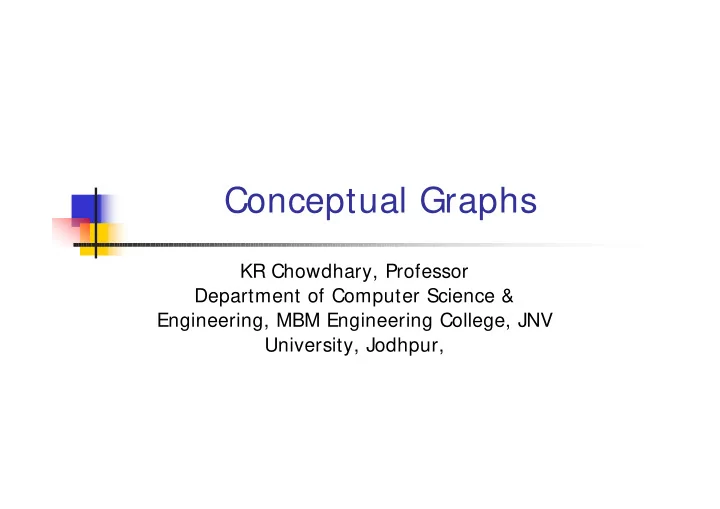

Conceptual Graphs KR Chowdhary, Professor Department of Computer Science & Engineering, MBM Engineering College, JNV University, Jodhpur,
Basics Conceptual graph (john Sowa 1984) is an example of network representation language A CG is a finite, connected, biparte graph Nodes are concepts or conceptual relations No labeled arcs, conceptual relation nodes represent relations 2
Simple examples Flies is a 1-ary bird flies Relation. dog colour brown Colour is a 2-ary Relation. father child parents mother Parents is a 3-ary relation 3
Basics Concept objects are concrete (those form an image, like – telephone, chair, etc.) or abstract (like – affection, hate, scold, appreciate, etc) Relation can be of any arity, in general arity n. Each conceptual graph represents single proposition, and a knowledge base will consist number of such graphs 4
Examples Person:mary agent object give Person:john book recipient CG for “Mary gave john the book.” 5
Representation CG allow us to represent specific but unnamed objects A unique token is # dog: # 1234 • Generic marker * is used to indicate an unspecified Individual. Thus, a node given by label dog is Equivalent to dog:* . • Named variables are represented by * varname . 6
Examples: dog:* X scratch ear agent object part instrument dog:* X paw part CG for the sentence “The dog scratches its ear with Its paw.” 7
Generalization and specialization The theory of CG includes a number of operations that create new graphs from existing graphs. These allow for the generation of new graph by either specializing or generalizing an existing graph. This is important for representation of semantics of NL. Four operations: copy, restrict, join, and simplify perform these jobs. 8
Copy and restrict Copy rule allows to form a new graph which is exact copy of previous. Restriction allows concepts nodes in a graph be replaced by a node representing their specialization . These cases are: 1. If concept is labeled by generic marker, it may be replaced by an individual marker 2. A type label may be replaced by one of its subtypes. 9
Restrict and join One use of restriction rule is to match two concepts so that a join can be performed Join and restriction allow the implementation of inheritance. Steps are: 1. Replacing generic marker by individual inherits the properties of the type by individual 2. Replacing type label by subtype defines inheritance between class and superclass. 10
Restriction agent eat bone object g1: dog colour brown Animal:”emma” porch location g2: color brown 11
Restriction.. dog:”emma” porch location g3: color brown Result: The restriction of g2. Note: g2 is generalization of g3. 12
Join agent eat bone object dog:”emma” location porch colour colour porch g4: Join of g1 and g3. Note: Join is a specialization rule. 13
Simplify agent eat bone object dog:”emma” location porch colour porch g5: Simplify of g4. 14
Uses of CGs: Natural language understanding Commonsense reasoning Individual sentences CGs can be joined together to construct larger CGs for bigger texts. 15
Recommend
More recommend